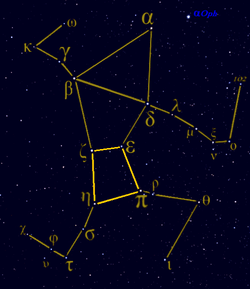Mu Herculis
 Historical view of the Hercules constellation showing Mu Herculis (μ Her) as one of stars in the hero's elbow. | |
| Observation data Epoch J2000 Equinox J2000 | |
|---|---|
| Constellation | Hercules |
| Right ascension | 17h 46m 27.52667s[1] |
| Declination | +27° 43′ 14.4379″[1] |
| Apparent magnitude (V) | 3.417 ± 0.014[1]/10.35/10.80 |
| Characteristics | |
| Spectral type | G5 IV[2]/M3.5 V/M4 V |
| U−B color index | 0.39/1.01 |
| B−V color index | 0.75/1.50 |
| Variable type | Periodic |
| Astrometry | |
| Radial velocity (Rv) | −16.1/-13.7 km/s |
| Proper motion (μ) | RA: −291.66[1]/-77.62 mas/yr Dec.: −749.60[1]/-270.12 mas/yr |
| Parallax (π) | 120.33 ± 0.16[1] mas |
| Distance | 27.11 ± 0.04 ly (8.31 ± 0.01 pc) |
| Absolute magnitude (MV) | 3.80/10.73/11.18 |
| Details | |
| μ Her A | |
| Mass | 1.00[2] M☉ |
| Radius | 1.77 ± 0.07[2] R☉ |
| Luminosity | 2.70 ± 0.16[2] L☉ |
| Surface gravity (log g) | 3.70[3] cgs |
| Temperature | 5,596 ± 80[2] K |
| Metallicity [Fe/H] | 0.21 ± 0.07[2] dex |
| Rotational velocity (v sin i) | 20 km/s |
| Age | 6.43 ± 0.04[2] Gyr |
| μ Her BC | |
| Mass | 0.31/0.31 M☉ |
| Radius | 0.48/0.4 R☉ |
| Luminosity | 0.005/0.003 L☉ |
| Other designations | |
Mu Herculis (μ Herculis) is a nearby star system about 27.1 light years from Earth in the constellation Hercules. Its main star, Mu Herculis A is fairly similar to the Sun although more highly evolved with a stellar classification of G5 IV. Since 1943, the spectrum of this star has served as one of the stable anchor points by which other stars are classified.[4] Its mass is about 1.1 times that of the Sun, and it is beginning to expand to become a giant.
The secondary component consists of a pair of stars that orbit about each other with a period of 43.2 years.[5] Mu Herculis A and the binary pair B-C are separated by 286 AUs. The stars B-C are separated from each other by 11.4 AUs. Their orbit is quite elliptic (e=0.18) and both stars swing each other between 9.4 and 13.5 AUs.
Etymology
In the catalogue of stars in the Calendarium of Al Achsasi Al Mouakket, this star was designated Marfak Al Jathih Al Aisr, which was translated into Latin as Cubitum Sinistrum Ingeniculi, meaning the left elbow of kneeling man.[6]
In Chinese, 天市左垣 (Tiān Shì Zuǒ Yuán), the Left Wall of Heavenly Market Enclosure, refers to an asterism which represents eleven old states in China, marking the left borderline of the enclosure, consisting of μ Herculis, δ Herculis, λ Herculis, ο Herculis, 112 Herculis, ζ Aquilae, θ1 Serpentis, η Serpentis, ν Ophiuchi, ξ Serpentis and η Ophiuchi.[7] Consequently, μ Herculis itself is known as 天市左垣三 (Tiān Shì Zuǒ Yuán sān, English: the Third Star of Left Wall of Heavenly Market Enclosure), represent Jiuhe (九河, lit. meaning nine rivers), possibly for Jiujiang, the prefecture-level city in Jiangxi, China, which is the same literally meaning with Jiuhe.[8][9] From this Chinese title, the name Kew Ho appeared.[10]
Star system
Star A is itself suspected to be a close binary with a low mass stellar or a large substellar companion, probably at 17.2 AU in an elliptic orbit. Nevertheless, the existence of such an object has still not been confirmed.
See also
References
- 1 2 3 4 5 6 van Leeuwen, F. (November 2007), "Validation of the new Hipparcos reduction", Astronomy and Astrophysics, 474 (2): 653–664, arXiv:0708.1752
 , Bibcode:2007A&A...474..653V, doi:10.1051/0004-6361:20078357
, Bibcode:2007A&A...474..653V, doi:10.1051/0004-6361:20078357 - 1 2 3 4 5 6 7 Yang, Wuming; Meng, Xiangcun (April 2010), "Models of μ Her with asteroseismic constraints", New Astronomy, 15 (4): 367–372, arXiv:0911.0749
 , Bibcode:2010NewA...15..367Y, doi:10.1016/j.newast.2009.11.001
, Bibcode:2010NewA...15..367Y, doi:10.1016/j.newast.2009.11.001 - ↑ Piau, L.; et al. (February 2011), "Surface convection and red-giant radius measurements", Astronomy and Astrophysics, 526: A100, arXiv:1010.3649
 , Bibcode:2011A&A...526A.100P, doi:10.1051/0004-6361/201014442
, Bibcode:2011A&A...526A.100P, doi:10.1051/0004-6361/201014442 - ↑ Garrison, R. F. (December 1993), "Anchor Points for the MK System of Spectral Classification", Bulletin of the American Astronomical Society, 25: 1319, Bibcode:1993AAS...183.1710G, retrieved 2012-02-04
- ↑ Turner, Nils H.; et al. (June 2001), "Search for Faint Companions to Nearby Solar-like Stars using the Adaptive Optics System at Mount Wilson Observatory", The Astronomical Journal, 121 (6): 3254–3258, Bibcode:2001AJ....121.3254T, doi:10.1086/321075
- ↑ Knobel, E. B. (June 1895), "Al Achsasi Al Mouakket, on a catalogue of stars in the Calendarium of Mohammad Al Achsasi Al Mouakket", Monthly Notices of the Royal Astronomical Society, 55: 429, Bibcode:1895MNRAS..55..429K, doi:10.1093/mnras/55.8.429
- ↑ (Chinese) 中國星座神話, written by 陳久金. Published by 台灣書房出版有限公司, 2005, ISBN 978-986-7332-25-7.
- ↑ (Chinese) AEEA (Activities of Exhibition and Education in Astronomy) 天文教育資訊網 2006 年 6 月 23 日
- ↑ (Chinese) English-Chinese Glossary of Chinese Star Regions, Asterisms and Star Name, Hong Kong Space Museum. Accessed on line November 23, 2010.
- ↑ Star Name - R.H. Allen p. 238
External links
- Jim Kaler's Stars, University of Illinois: MU HER (Mu Herculis)
- SolStation: Mu Hercules4